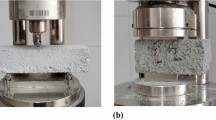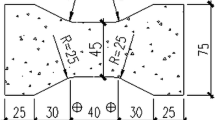Abstract
In this study, a series of the dog-bone specimens were prepared to investigate the effects of the steel fiber types, fiber volume fractions and water/cement ratios on the tensile properties of steel fiber reinforced mortar (FRM) exposed to elevated temperatures by the uniaxial tensile test. The main properties of the FRM were examined, including the tensile strength, peak strain, elastic modulus and Poisson’s ratio. The results indicated that the tensile strength, elastic modulus and Poisson’s ratio of FRM gradually decreased with increasing exposed temperature, while the peak strain gradually increased. At room temperature, the tensile strength of mortar with the straight fiber (QP), hooked-end fiber (QW) and corrugated fiber (QB) were greater than that without steel fiber, and the effects of the hooked-end and corrugated fibers on the tensile behavior of FRM were more significant than that of the straight fiber, especially at the higher temperatures. Finally, the prediction formulas for the tensile strength and elastic modulus of FRM exposed to elevated temperatures were proposed by fitting the experimental data.











Similar content being viewed by others
References
Farhad A, Bijan S (2014) Constitutive relationships for steel fiber reinforced concrete at elevated temperatures. Fire Technol 50:1249–1268
Kim J, Lee GP, Moon DY (2017) Evaluation of mechanical properties of steel-fiber-reinforced concrete exposed to high temperatures by double-punch test. Constr Build Mater 79:182–191
Min L, Qian CX, Wei S (2004) Mechanical properties of high-strength concrete after fire. Cem Concr Res 34(6):1001–1005
Smarzewski P (2019) Study of toughness and macro/micro-crack development of fiber-reinforced ultra-high-performance concrete after exposure to elevated temperature. Material 12(8):1944–1996
Graybeal BA, Baby F (2013) Development of direct tension test method for ultra-high-performance fiber-reinforced concrete. ACI Mater J 110(2):177–186
Ding Y, Zhang F, Torgal F (2012) Shear behavior of steel fiber reinforced self-consolidating concrete beams based on the modified compression field theory. Compos Struct 94:2440–2449
Eik M, Puttonen J, Herrmann H (2015) An orthotropic material model for steel fiber reinforced concrete based on the orientation distribution of fiber. Compos Struct 121:324–336
Abdallah S, Fan M, Zhou X, Geyt S (2016) Anchorage effects of various steel fiber architectures for concrete reinforcement. Int J Concr Struct Mater 10(3):325–335
Kwan AKH, Chu SH (2018) Direct tension behavior of steel fiber reinforced concrete measured by a new test method. Eng Struct 176:324–336
Xiong MX, Liew JYR (2015) Spalling behavior and residual resistance of fiber reinforced ultra-high- performance concrete after elevated temperatures. Mater Constr 65(320):1–10
Faiyadh FI (1989) AI-Ausi MA (1989) , Effect of elevated temperature on splitting tensile strength of fiber concrete. Int J Cem Compos Lightw Concr 11(3):175–178
Lau A, Anson M (2006) Effect of high temperatures on high performance steel fiber reinforced concrete. Cem Concr Res 36:1698–1707
Khaliq W, Kodur V (2011) Thermal and mechanical properties of fiber reinforced high performance self-consolidating concrete at elevated temperatures. Cem Concr Res 41(11):1112–1122
Xargay H, Folino P, Sambataro L, Etse G (2018) Temperature effects on failure behavior of self-compacting high strength plain and fiber reinforced concrete. Constr Build Mater 165:723–734
Kodur Venkatesh KR, Banerji S, Solhmirzaei R (2020) Test methods for characterizing concrete properties at elevated temperature. Fire Mater 44:381–395
Shah SNR, Akashah FW, Shafigh P (2019) Performance of high strength concrete subjected to elevated temperatures: a review. Fire Technol 55(5):1571–1597
Tai YS, Pan HH, Kung YN (2011) Mechanical properties of steel fiber reinforced reactive powder concrete following exposure to high temperature reaching 800°C. Nucl Eng Des 241(7):2416–2424
Peng GF, Yang WW, Zhao J, Liu YF, Bian SH, Zhao LH (2006) Explosive spalling and residual mechanical properties of fiber-toughened high-performance concrete subjected to high temperatures. Cem Concr Res 36(4):723–727
Annerel E, Taerwe L (2009) Revealing the temperature history in concrete after fire exposure by microscopic analysis. Cem Concr Res 39(12):1239–1249
Alarcon-Ruiz L, Platret G, Massieu E, Ehrlacher A (2005) The use of thermal analysis in assessing the effect of temperature on a cement paste. Cem Concr Res 35:609–613
Sukontasukkul P, Pomchiengpin W, Songpiriyakij S (2010) Post-crack (or post-peak) flexural response and toughness of fiber reinforced concrete after exposure to high temperature. Constr Build Mater 24:1967–1974
Choumanidis D, Badogiannis E (2016) The effect of different fibers on the flexural behavior of concrete exposed to normal and elevated temperatures. Constr Build Mater 129:266–277
Pajak M, Ponikiewski T (2013) Flexural behavior of self-compacting concrete reinforced with different types of steel fibers. Constr Build Mater 47:397–408
Dong JK, Naaman AE, S. EI-Tawil, (2008) Comparative flexural behavior of four fiber reinforced cementitious composites. Cem Concr Compos 30(10):917–928
Wu Z, Shi C et al (2016) Effects of steel fiber content and shape on mechanical properties of ultra-high- performance concrete. Constr Build Mater 103:8–14
Yoo DY, Kim S et al (2017) Effects of fiber shape, aspect ratio, and volume fraction on flexural behavior of ultra-high-performance fiber-reinforced cement composites. Compos Struct 174:375–388
Wille K, El-Tawil S, Naaman AE (2014) Properties of strain hardening ultra-high-performance fiber reinforced concrete (UHP-FRC) under direct tensile loading. Cem Concr Compos 48:53–66
Abdallah S, Fan M, Rees DWA (2017) Effect of elevated temperature on pull-out behavior of 4DH/5DH hooked end steel fibers. Compos Struct 165:180–191
Ren GM, Wu H, Fang Q, Liu JZ (2018) Effects of steel fiber content and type on static mechanical properties of UHPCC. Constr Build Mater 163:826–839
Chinese Standard (2009) CECS 13–2009. Standard test methods for fiber referenced concrete. Beijing: China Planning Press
Haddad R, Al-Saleh R, Al-Akhras NM (2008) Effect of elevated temperature on bond between steel reinforcement and fiber reinforced concrete. Fire Saf J 43:334–343
Kodur V, McGrath R (2003) Fire endurance of high strength concrete columns. Fire Technol 89:73–87
Bengar HA, Shahmansouri AA, Zangebari Sabet NA, Kabirifar K, Tam VWY (2020) Impact of elevated temperatures on the structural performance of recycled rubber concrete: experimental and mathematical modeling. Constr Build Mater 255:119374
Abid M, Hou XM, Zheng WZ, Hussain RR (2019) Effect of fibers on high-temperature mechanical behavior and microstructure of reactive powder concrete. Material 12(2):1–30
Eva V, Dana K, Lenka S, Magdaléna D, Martin K, Robert Č (2018) High temperature durability of fiber reinforced high alumina cement composites. Constr Build Mater 162:881–891
Deshpande AA, Kumar D, Ranade R (2019) Influence of high temperatures on the residual mechanical properties of a hybrid fiber-reinforced strain-hardening cementitious composite. Constr Build Mater 208:283–295
Farhad A, Bijan S (2014) High strength polypropylene fiber reinforcement concrete at high temperature. Fire Technol 50(2):1229–1247
Ruano G, Isla F, Luccioni B, Zerbino R, Giaccio G (2018) Steel fibers pull-out after exposure to high temperatures and its contribution to the residual mechanical behavior of high strength concrete. Constr Build Mater 163:571–585
Carrillo J, Ramirez J, Lizarazo J (2019) Modulus of elasticity and Poisson’s ratio of fiber-reinforced concrete in Colombia from ultrasonic pulse velocities. J Build Eng 23:18–26
Shan Z, Zhiwu Y, Chen F, Li X, Gao J (2019) Experimental investigation of mechanical behaviors of self-compacting concrete under cyclic direct tension. Materials 12(7):1047
Dougill JW (1968) Some effects of thermal volume changes on the properties and behavior of concrete. The Structure of Concrete, Cement and Concrete Association, London, pp. 499–513
Roux FJP (1974) Concrete at elevated temperature. PHD Thesis, University of Cape Town
Fu YF, Wong YL, Poon CS, Tang CA, Lin P (2004) Experimental study of micro/macro crack development and stress-strain relations of cement-based composite materials at elevated temperatures. Cem Concr Res 34(5):789–797
Chan YN, Peng GF, Anson M (1999) Fire behavior of high-performance concrete made with silica fume at various moisture contents. ACI Mater J 97(3):405–409
Tai YS, Pan HH, Kung YN (2011) Mechanical properties of steel fiber reinforced reactive powder concrete following exposure to high temperature reaching 800 C. Nuclear Eng Design 241(7):2416–2424
Sultan HK, Alyaseri I (2020) Effects of elevated temperatures on mechanical properties of reactive powder concrete elements. Constr Build Mater 261:120555
Acknowledgements
This research work is financially supported by the National Natural Science Foundation of China (Grant No. U1704254, 52008377 and 51978629), Open Research Fund Program of State key Laboratory of Hydro science and Engineering (Sklhse-2017-D-01), Key Research Projects of Colleges and Universities in Henan Province (15A560038) and Henan province transportation science and technology plan project (2020J-2-7).
Author information
Authors and Affiliations
Corresponding authors
Additional information
Publisher's Note
Springer Nature remains neutral with regard to jurisdictional claims in published maps and institutional affiliations.
Rights and permissions
About this article
Cite this article
Gao, D., Dou, S., Pang, Y. et al. Experiment study on tensile properties of steel fiber reinforced mortar exposed to elevated temperatures. Mater Struct 54, 136 (2021). https://doi.org/10.1617/s11527-021-01705-x
Received:
Accepted:
Published:
DOI: https://doi.org/10.1617/s11527-021-01705-x




